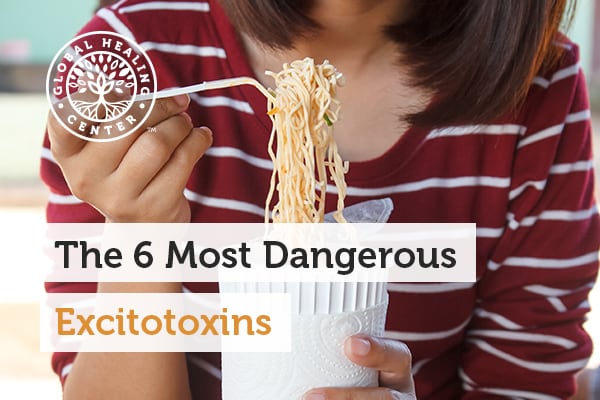
If you’ve ever felt compelled to take another bite, despite feeling full, the concern may not be a lack of self control. In fact, the issue may not even be with you at all: It could be an excitotoxin.
These non-essential amino acids stimulate or “excite” the umami or savory taste buds making food seem more flavorful than it really is. These compounds are abundant in most processed foods and restaurant meals, and many people are unknowingly consuming these compounds in large amounts on a daily basis.
Know Your Food
Despite public outcry, processed foods remain loaded with excitotoxins, all of which have been linked to brain cell death, infertility, issues with sexual development, aggressive behaviors, and hormonal disorders. Here’s a list of the 6 most dangerous excitotoxins you need to avoid.
1. MSG (Monosodium Glutamate)
This salt form of glutamate, or glutamic acid, has been known to trigger headaches. Glutamate easily crosses the blood-brain barrier, stimulating cell receptors that triggers cell death.[1]
While the body naturally produces glutamate when needed to trigger cell termination, flooding the body with dietary glutamate can seriously disrupt normal cellular function, especially in the brain. Avoid foods with MSG, but don’t think food is MSG-free just because you don’t see it in the ingredients list.[2] MSG also appears under the names:
- Natural flavors
- Flavoring
- Hydrolyzed vegetable protein
- Autolyzed protein
- Plant protein
- Textured protein
- Yeast extract
- Nutritional yeast
- Carrageenan
- Anything with glutamate
2. Aspartate
Aspartate, or aspartic acid, acts very similarly to glutamate.[3] This non-essential amino acid triggers NMDA receptors in cells, another of the cellular receptors used to initiate cell death. Most humans receive aspartate through consuming aspartame, an artificial sweetener often hidden in many processed foods. It has been linked with serious neurological effects such as headaches, sleep disorders, and seizures.[4]
3. Domoic Acid
Another non-essential amino acid, domoic acid occurs naturally in shellfish. Overconsumption has shown to lead to the development of epilepsy, especially in the elderly.[5] If you’re a seafood eater, pick wild-caught varieties of fish like salmon, trout, and tuna. This way you are receiving your omega-3 fatty acids without the excitotoxins and pollutants common in shellfish and farm-raised seafood.
4. L-BOAA
Also known as ODAP, this protein is another excitotoxin that behaves in similar fashion as glutamate. It naturally occurs in the grass pea and similar plant species. Overexposure to grass pea and L-BOAA leads to neurolathyrism, a disorder that affects motor skills and movement and can lead to paralysis.[6]
5. Cysteine
Industrially created by hydrolysis of human hair and poultry feathers, this excitotoxin is important for artificial flavor creation. It reacts with sugars in a process known as the Maillard reaction, resulting in meaty and savory flavors. High cysteine levels are associated with Parkinson’s and Alzheimer’s disease.[7]
6. Casein
This protein compound occurs in cheese at naturally high levels. Twenty percent of casein is glutamic acid which makes for a tasty treat; however, it also increases glutamate overload. Casein is often used by food producers to improve flavor, although it is also frequently used to increase protein levels in fitness products.
Points to Remember
Excitotoxins such as MSG, aspartame, and cysteine have been linked to several adverse health effects, some of which may be irreversible. Some people have reported allergic reactions like hives, shortness of breath, and rashes. Others have reported the well-known MSG headache, as well as rapid heartbeat and stomach cramping. The most serious reactions involve depression and paranoia.
Have you had a reaction to MSG or another of these excitotoxins? Share your experience so we can all better understand the dangers of these compounds.
References (7)
- Olney JW. Excitotoxins in foods. Neurotoxicology. 1994 Fall;15(3):535-44.
- Scopp AL. MSG and hydrolyzed vegetable protein induced headache: review and case studies. Headache. 1991 Feb;31(2):107-10.
- Chen PE1, Geballe MT, Stansfeld PJ, Johnston AR, Yuan H, Jacob AL, Snyder JP, Traynelis SF, Wyllie DJ. Structural features of the glutamate binding site in recombinant NR1/NR2A N-methyl-D-aspartate receptors determined by site-directed mutagenesis and molecular modeling. Mol Pharmacol. 2005 May;67(5):1470-84.
- Humphries P1, Pretorius E, Naud H. Direct and indirect cellular effects of aspartame on the brain. Eur J Clin Nutr. 2008 Apr;62(4):451-62.
- Andermann F, Carpenter S, Zatorre RJ, Cashman NR. Temporal lobe epilepsy caused by domoic acid intoxication: evidence for glutamate receptor-mediated excitotoxicity in humans. Ann Neurol. 1995 Jan;37(1):123-6.
- Knig G1, Hartmann J, Krause F, Deckert J, Heinsen H, Ransmayr G, Beckmann H, Riederer P. Regional differences in the interaction of the excitotoxins domoate and L-beta-oxalyl-amino-alanine with [3H]kainate binding sites in human hippocampus. Neurosci Lett. 1995 Mar 3;187(2):107-10.
- Parsons RB1, Waring RH, Ramsden DB, Williams AC. In vitro effect of the cysteine metabolites homocysteic acid, homocysteine and cysteic acid upon human neuronal cell lines. Neurotoxicology. 1998 Aug-Oct;19(4-5):599-603.
†Results may vary. Information and statements made are for education purposes and are not intended to replace the advice of your doctor. If you have a severe medical condition or health concern, see your physician.







